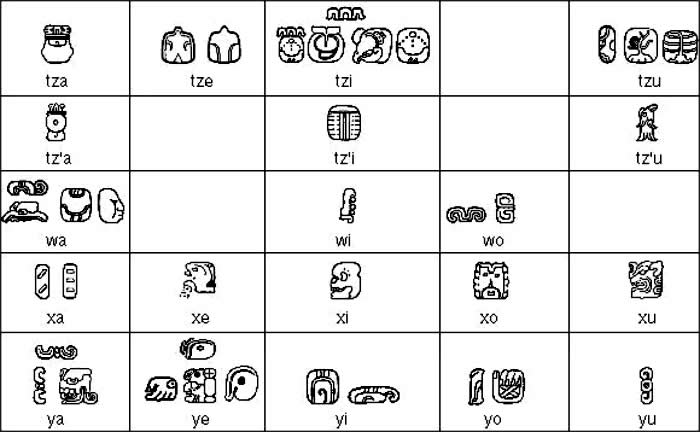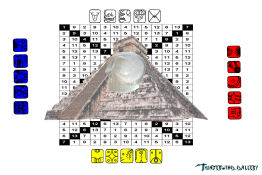
In a blog post by Banter from the Bat Cave, he mentioned that historian Ambeth Ocampo wrote in an issue of Philippine Daily Inquirer in August 9, 2013, that “In pre-war Manila, Tansan was a popular brand of fizzy water…It was sold with the distinct metal bottle caps that have since been called tansan by Filipinos.”īut why are we suddenly talking about tansan in the age of plastic caps? It’s because we suddenly want to try Jar’s suggestion-enjoy the Tansan Carbonated Water with “a swig of cold brew concentrate (a spritz of lemon too if you have).” The coffee specialty store sells Tansan, but last time we checked, it’s already sold out. The Tansan carbonated water started using Painter’s metal crown cap in 1902 such that when the drink arrived on Philippine shores in the 1920s, via the Swiss trading firm Lutz & Zuellig, its sole distributor at that time, Tansan already had that cap on it.
TANSAN ASPECT IN MAYA GLYPHS FULL
The Maya are the only known civilisation in the Americas that developed a full writing system with which they could record the actual sounds of anything they could speak. Yaxchilan Lintel 24 (723/726)British Museum. Painter launched the Crown Cork and Seal Company in 1892 to manufacture and market the cap. Untangling Maya Glyphs The basics of a beautiful script. The Crown Cork bottle cap was a nifty invention and it was cheap to produce. The Crown Cork bottle cap had a “corrugated-flange edge and was lined with a thin cork disc and a special paper backing to seal the bottle and prevent contact between the metal cap and the drink,” describes, a site maintained by the National Inventors Hall of Fame (NIHF), an organization that honors the visionaries whose patented inventions have changed our world. On the other side of the world, in 1892, Maryland-born William Painter had already invented the Crown Cork. There were already carbonated beverages at that time, but the stoppers and bottle caps weren’t leak-proof. And so, the entrepreneurial Englishman decided to bottle it up for commercial consumption. He called the water brand Tansan, which literally means “carbonated water” in Japanese. It was in those years while hunting in the mountains of Takarazuka, Hyogo Prefecture that he discovered a potent source of carbonated mineral spring.Ī post shared by Photography By Jar Concengco sent samples of the water to London for analysis, and found out that it was “an excellent mineral spring” that can be enjoyed by the rest of the world. Uncorking the annals of Wilkinson, makers of Tansan carbonated water, we found out that it was in 1872 when England-born John Clifford Wilkinson traveled to Japan. So how did we end up calling the crown cap tansan? Well, tansan-the word we use to refer to the crown-like caps that cover our Coca-Colas and Pale Pilsens-is actually of Japanese origin, as our good friend, photographer Jar Concengco on Instagram), pointed out in a recent Instagram post. Tansan is a popular Japanese brand of carbonated water that dates back to the early 1900s. Many of us would probably know that among Japanese folks, san is a title of respect affixed to a name-like Hiroyuki-san, Kurosawa-san, Kondo-san, Osaka-san, or Yoko-san. While it sounds like a very Filipino term -along the lines of pinsan, minsan, buksan, orasan, ubusan, iwasan-it’s also very Japanese. On the example of three texts (Cancuen Panel 3, Laxtunich Panel 1 and Aguateca Stela 1) it attempts to develop methodology appropriate for the analysis of the genre of Maya glyphic inscriptions.We Pinoys have referred to the bottle caps that seal our carbonated drinks and beers as tansan for as long as we can remember. It analyses how the composition, gestures, pictorial signs and text contribute to deliver the final message. This projects attempts to define and describe the multimodality of ancient Maya inscriptions, including identifying modalities utilized by ancient scribes. Yet it seems that Maya scribes did not develop the concept of strict division between image and text: the same hands drew both, freely combining elements belonging to the visual and linguistic modalities.


Once the writing system was satisfactorily deciphered, the main focus shifted to epigraphic analysis of glyphs and linguistic analysis of texts recorded by glyphs, frequently leaving out the accompanying image. In the times when Maya writing was an enigma, the analysis of Maya inscriptions necessarily focused on iconography and the purely visual aspect of an inscription.


 0 kommentar(er)
0 kommentar(er)
